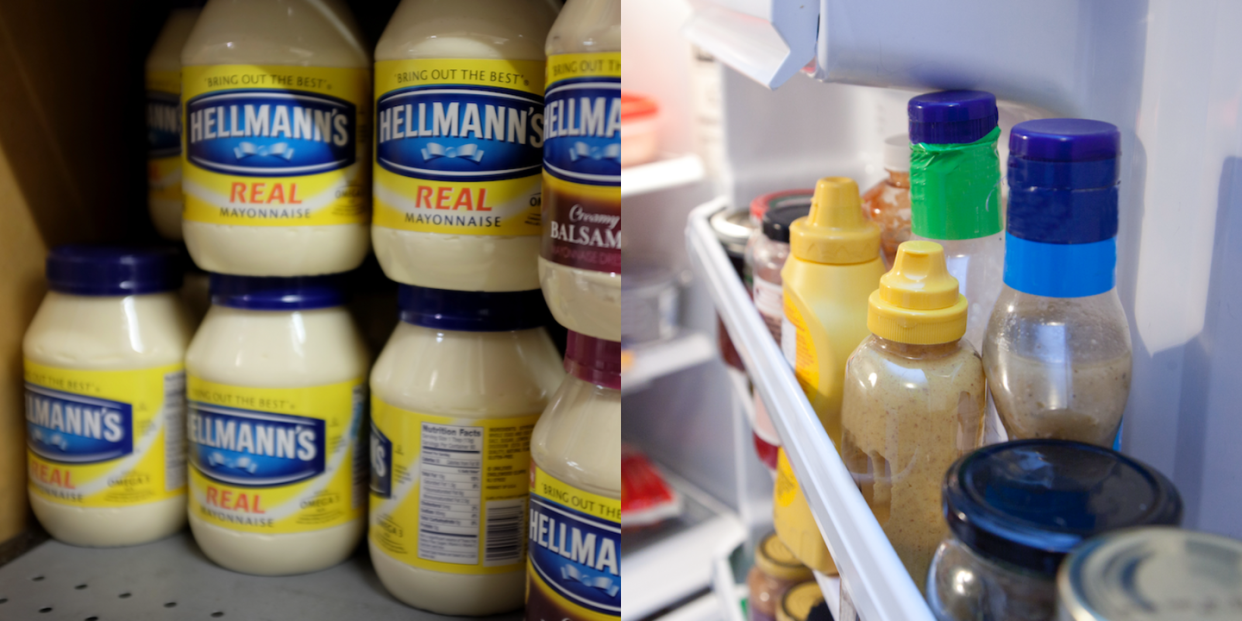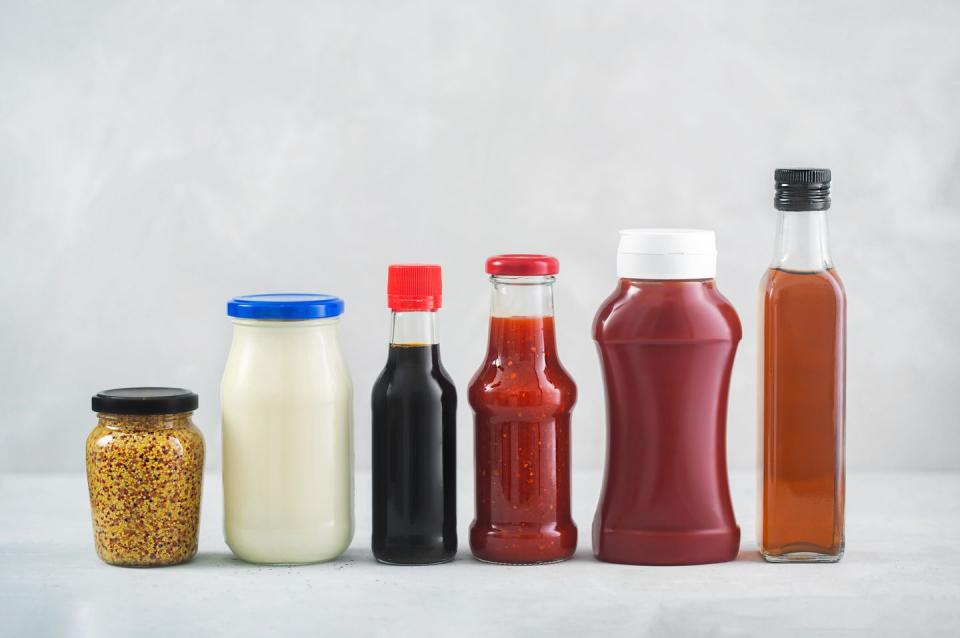Condiments You Absolutely CANNOT Eat After They Expire

Have you ever done a deep clean of your fridge and noticed that the shelf doors have essentially turned into time capsules stashing condiments way past their expiration dates?
Obviously, it’s time to toss the mystery mayo that’s leftover from a long-ago barbecue and the forgotten-about jar of salsa that’s turned into a science experiment. But there are all kinds of other scenarios that are more befuddling: Do you need to get rid of the sour cream that has a pool of liquid on top of it, but hasn’t reached its expiration date? (You’ve probably got a couple days, btw, but the end is nearing for your taco topping). And what about ketchup and mustard from last summer’s cookouts?
If you find yourself in a condiment conundrum, and you’re deciding what to toss and what to keep, there are a few general rules to be mindful of, says nutritionist Mary Sabat, MS, RDN, LD.
First things first: Is the bottle opened? Unopened condiments are generally going to have a longer shelf life compared to open ones since they haven’t been exposed to potential contaminants that can speed up bacteria growth, Sabat says.
“Once a bottle is opened, the shelf life can be significantly reduced due to increased exposure to bacteria,” Sabat says.
Proper storage is also a biggie. Many condiments need to be stored in a cool, dry place away from sunlight and heat, while refrigeration is necessary for things like mayo and creamy salad dressings that will otherwise spoil.
Expiration dates printed on the condiment bottles are really meant to tell you when the product is at its peak quality, Sabat says. Expired sauces, spreads, and dressings will likely lose their flavor over time, and, worst-case scenario, could make you sick.
With that info out of the way, here are 13 condiments you should never eat after their expiration dates (and in some cases, may even need to toss earlier).
Mayo Needs to Be Tossed Two Months After Opening
A safe rule of thumb is anything that contains mayonnaise should be tossed at the time of its expiration, especially if the jar has been opened, says dietitian Bess Berger, RDN, with the New Jersey-based company Nutrition by Bess.
Store-bought mayo usually contains acids which help prevent spoilage and kill off bacteria. But you may need to toss a half-full bottle of mayo before its expiration date if it’s been sitting out in the sun all day during a backyard barbecue, Berger says. Also, after it's opened, it should go in the fridge for up to two months, according to the USDA.

Keep Close Tabs on Mayo-Based Dips, Too
From garlic aioli to remoulade and tartar sauces, there are all kinds of dipping sauces and spreads that contain mayo, and Berger says it’s best practice to toss them when they’re expired.
“Another general rule of thumb is if a dip or condiment tastes different from when you first open it, throw it out,” she says. “Same holds true if it's discolored or extra watery.”
Horseradish Loses Its Zing
“As soon as the jar of horseradish is exposed to air, that sharp, spicy flavor begins to fade,” says Jared Kent, a sous chef at Good Roots in Akron, Ohio. By the time it reaches the expiration date, it's better to opt for a fresh jar and get the whole experience, he says.
Sour Cream Is A Wild Card
Sour cream can spoil quicker than other dairy products, and the USDA says it can be kept in the fridge for one to three weeks. But if you start to see it separate and a pool of liquid build on the top, consider that your warning sign that you should use it up in the next couple of days, according to Eat By Date. (This isn’t a condiment that freezes well). Also, if you notice any mold forming, toss out the entire container.
Use Up Chutney Quickly After Opening
While you can keep chutney in your pantry for a year after buying it, you’ll want to move it to the fridge as soon as you break the seal on this savory Indian condiment that’s made from fruits or veggies with vinegar, sugar and spices. Once it moves to the fridge, you’ve got a month or two to polish it off, according to FoodSafety.Gov’s FoodKeeper App. The vinegar and acids from the fruit helps preserve it, but it can still eventually grow mold.
BBQ Sauce Can Get Moldy
Don’t sauce it, toss it if you’re noticing anything that’s off about your jar of barbecue sauce, like fuzzy mold, a change in texture or a funky smell. While most store-bought barbecue sauces have lots of preservatives in them, you’ve got about four months to use up an opened bottle of the good stuff, according to FoodSafety.gov.
Toss Your Ranch If It Changes Consistency
A popular choice for salads and dipping, Ranch dressing includes buttermilk, sour cream, and mayonnaise, which can all go bad over time, says Chef Jessica Randhawa of The Forked Spoon. “Eating expired ranch dressing could lead to foodborne illnesses, especially if the ranch has been improperly stored,” she says. It's important to discard this dressing if it's past its expiration date or if you notice changes in its smell, color, or consistency, Randhawa says.
If you need some inspiration to use up a bottle of the salad dressing, here are 55 genius ways to use up ranch.
Blue Cheese is a ‘breeding ground for bacteria’
Blue cheese dressing is made with blue cheese crumbles, mayonnaise, sour cream, and other dairy products, Randhawa says, and it’s another one of those creamy dressings that can spoil after its expiration date. Because there are so many dairy products in blue cheese, it can be a breeding ground for harmful bacteria, and potentially cause food poisoning, she says. “And the potent smell of the cheese can mask any off odors,” she says.
Spoiled Caesar Dressing Could Contain Salmonella
Caesar dressing often contains raw egg yolks, olive oil, and cheese, which can all become problematic if consumed past their expiration dates, Randhawa says. The raw egg yolks, though, are of particular concern because they can be a source of Salmonella, a bacteria that has potential to make you sick. “It’s essential to pay close attention to the shelf-life of Caesar dressing to ensure it's still safe to consume,” Randhawa says.
Don’t Eat Thousand Island Dressing If The Smell is Off
Other indicators that it’s time to toss the jar of Thousand Island is if you notice changes in the color or texture, Randhawa says. Thousand Island has a creamy mayo base and can spoil and potentially cause foodborne illness, she says.
Soy Sauce Can Become Stale
Although soy sauce has a long shelf life, it can still expire, says Nina Engle of Ping Pong Thai in Las Vegas. In fact, FoodSafety.gov says soy sauce can hang out in your pantry for three years, but once you open it, you need to move it to the fridge and it’s only good for about a month.
When it’s past its prime, soy sauce can develop a stale or rancid flavor, making it unappetizing to use, she says.
Mustard Can Turn Rancid
Totally fine if you use the same bottle of mustard throughout the entire barbecue season. Mustard has some stamina. It’s good for a year after you open it so long as you keep it in the fridge, according to FoodSafety.gov. Quality, not safety, is the reason your mustard bottle says to pop it in the fridge after opening. If your mustard is expired, it will have a rancid taste.
Ketchup Can Go Sour
Just like its companion mustard, ketchup should get moved to the fridge after opening to help maintain its quality. But unlike mustard, ketchup is only good for about six months after opening and refrigerating, according to FoodSafety.gov. Afterwards, it can become sour or even moldy.
You Might Also Like

